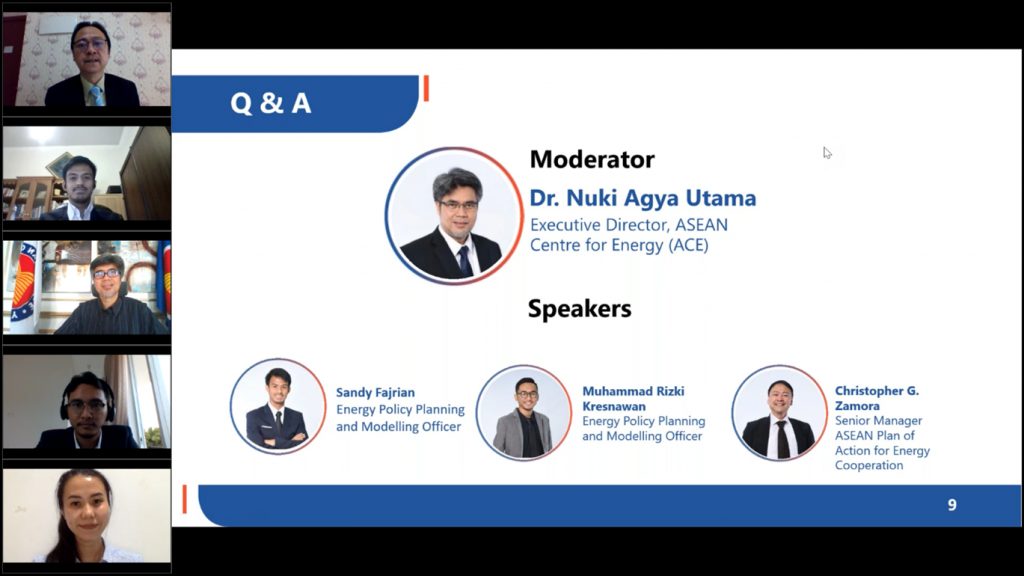Jakarta, 16 March 2021
Reflecting on ASEAN Plan of Action and Energy Cooperation (APAEC) Phase II: 2021-2025 and The 6th ASEAN Energy Outlook (AEO6), which were proposed on the 38th ASEAN Ministers on Energy Meeting (AMEM) held virtually in Vietnam on November 19th, 2020, ASEAN Centre for Energy (ACE) held a webinar to disseminate the importance of APAEC and AEO6 as manuals for ASEAN member states (AMS) to pursue sustainable future.
The event was held on March 16th, 2021, moderated by Executive Director of ACE, Dr. Nuki Agya Utama. ACCEPT’s research analyst, Mr. Muhammad Rizki Kresnawan, was invited as a speaker, together with other colleagues from ACE. Mr. Rizki presented the highlights of Thematic Energy Insights from AEO6.

(Photo caption: Mr. Sandy Fajrian, Mr. Muhammad Rizki Kresnawan, and Mr. Christopher G. Zamora in Q&A session that moderated by Dr. Nuki Agya Utama).
As main objectives, AMS have agreed on increasing renewable energy (RE) share in power plant to 23% in Total Primary Energy Supply and 35% share of RE in ASEAN installed power capacity by 2025. In addition, they also targeted a reduction of energy intensity by 32% in 2025. Phase II has just begun, marking an important effort toward a sustainable future.
Several real-life energy-related issues are extremely close to our activity. For example, the ownership of private transportation contributes to 23% greenhouse gases, 26% total final energy consumption, and 80% gasoline and diesel consumption. As household income increases, society’s buying power also increases. If it is not handled by alternative solutions, such as efficient public transportation and, electric/hybrid vehicle, the figures will keep increasing, as Mr. Kresnawan explained during his presentation. Expanding the multilateral exchange will crucially be important for ASEAN Power Grid, while fuel switching and improving the efficiency will shape the new role of fossil fuel in the era of energy transition in ASEAN.
Furthermore, ASEAN countries are prone to humid warm weathers due to its geographical location. The importance of air conditioning at indoor location is not subject to compromise. It is expected soon that air-conditioned room will increase. Therefore, from now on, robust regulations and improvement on the current standards are required to tackle the issue at an early stage.
Another issue is to expand cleaner cooking on rural areas in ASEAN. Smoke that is produced by wood or charcoal will damage the atmosphere and cause respiratory problems. A proposed solution is a transition from traditional cooking fuel to the cleaner cooking fuel such as LPG. Aside from that, there is also an option to utilise biogas as affordable and cleaner alternative for those who have limited access.
Wrapping up each speakers’ presentation, audiences had the opportunity to interact with them during questions and answers session. A question arose whether adding too much RE will support EV but destabilise the grid. Mr. Rizki explained that grid stability will still be an issue in order to pursue higher penetration of EV deployment. However, considering the constant improvement of the ASEAN power grid, it will trigger the EV deployment indirectly. Hence, having EV initiatives alone can be seen as a beneficial for the region, aside of the rescuing oil import and urban air pollution. With the coherence approach, it seems promising.
TA/HHS